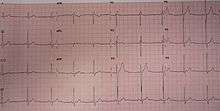Benign early repolarization
Benign early repolarization also known as early repolarization (abbr.: BER) is found on ECG in about 1% of those with chest pain.[1] It is diagnosed based on an elevated J-point / ST elevation where the ST segment is concave up. It is believed to be a normal variant.[1]

Benign early repolarization that occurs in the inferior and lateral portion of the heart muscle is associated with ventricular fibrillation. The association, revealed by research performed in the late 2000s, is small.
Associations with serious condition
Research in the late 2000s has linked this finding when found in the inferior and lateral ECG leads to ventricular fibrillation particularly in those who have fainted or have a family history of sudden cardiac death.[2] The magnitude of the association is however small.[2]
Electrocardiography
On an electrocardiogram (EKG or ECG), benign early repolarization may produce an elevation of the ST segment, similar to that observed in heart attacks (myocardial infarction). However, with benign early repolarization, the ST segment is usually concave up, rather than concave down (as with heart attacks), and there is a notable absence of reciprocal changes suggestive of ischemia on the EKG.
Epidemiology
Benign early repolarization occurs in about 1 to 2 percent of the general population.[3] The prevalence is higher in men, young adults, adolescent Africans, African-Americans, and athletes.[3]
References
- Brady WJ, Chan TC (1999). "Electrocardiographic manifestations: benign early repolarization". J Emerg Med. 17 (3): 473–8. doi:10.1016/S0736-4679(99)00010-4. PMID 10338242.
- Stern S (April 2011). "Clinical aspects of the early repolarization syndrome: a 2011 update". Ann Noninvasive Electrocardiol. 16 (2): 192–5. doi:10.1111/j.1542-474X.2011.00429.x. PMID 21496171.
- Pérez-Riera, AR; Abreu, LC; Yanowitz, F; Barros, RB; Femenía, F; McIntyre, WF; Baranchuk, A (2012). ""Benign" early repolarization versus malignant early abnormalities: clinical-electrocardiographic distinction and genetic basis". Cardiology Journal. 19 (4): 337–46. doi:10.5603/CJ.2012.0063. PMID 22825893.